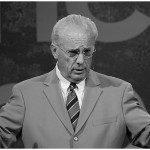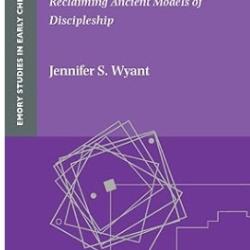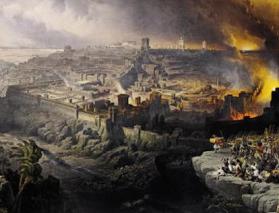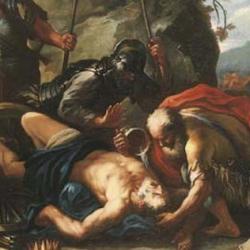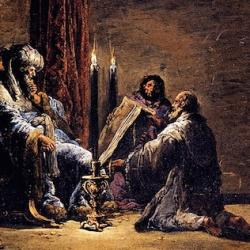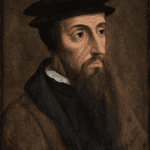When David was exiled to the stronghold to flee Saul, warriors from Israel’s tribes gathered to him. 1 Chronicles 12:16-18 records his reception of men from Judah and Benjamin. He greets with understandable suspicion; these are Saul’s kinsman, after all. He asks if they have come in peace or to betray him. Clothed by the Spirit, Amasai assures David of their intentions.
Verses 17-18 run in neat parallel:
A. David said:
B. If you come in peace
C. to help, my heart will be one with you.
D. If you come to betray, God judge between us.
Amasai responds:
A’. We are yours, David.
B’. Peace, peace, peace
C’. to him who helps.
D’. God helps you!
This answer seals the union. Since they come in peace, peace, peace to help, help, David’s heart is knit to theirs. He is bone and flesh with Israel (11:1). Now, they are united not only in flesh but in heart.
This scene exhibits what one scholar has called as “pattern of camaraderie.” Scott Hahn sums up the evidence (Kingdom of God as Liturgical Empire, 48): “All that David accomplishes he does in consultation and cooperation with the people. The word used again and again is ‘all’ (kol) – all Israel, all the assembly, all the people, all the rest of the people. Reference is made to the perfect sympathy of the people with David, their ‘singleness of purpose’ and ‘single mind’ (12:33, 38). . . . Longs lists are provided of the names of those who allied themselves with David. Joab is credited with the capture of Jerusalem; David’s slaying of Goliath is overlooked while Elhanan’s killing of Goliath’s brother is mentioned (20:5). The people are not passive investors in David’s fortunes; the kingdom is more than one man. The men around David are shown as making considered decisions of allegiance and self-sacrifice and impassioned oaths of loyalty; according to the Chronicler, they offer indispensable help to the king and his kingdom. The message to the Chronicler’s audience is clear: their own zeal and devotion to rebuilding the kingdom will be remembered.” Hahn points to the repeated use of ‘etzer, “help,” which occurs seven times in 12:1-22 (12:1, 17, 18 (2x), 19, 21, 22; Japhet, I & II Chronicles, 260).
We can go further, guided by that flesh and bone reference, which alludes, as Hahn points out, to Genesis 2:23. David is not only the chief among a company of warriors. He functions as head of bride. The scene has nuptial as well as political and familial overtones (Hahn, 48). Hahn asks, “Could the Chronicler be making a comparison between the union of Israel and its ‘head’? Do we see here an attempt to interpret the origins of the bridal imagery used by the prophets to describe Israel’s relationship with God . . . ? Does David, as king, stand in the relationship of bridegroom to God’s betrothed Israel?” (49). Hahn’s cautious Yes is the right answer, though too hedged. The nuptial dimension of kingship is already evident in the account of Saul’s reign in 1 Samuel, and the use of etzer itself points back to the need for Adam to have a helper.
William Johnstone (1 & 2 Chronicles, 150) notes the Chronicler’s extensive use of chazaq, “to make strong.” 15 of the 24 uses in the Hebrew Bible occur in Chronicles, usually to mean “assume control, be confirmed, show resolve, grow in strength” and usually used of kings (2 Chronicles 1:1; 12:13; etc.). In 11:10, though, a title verse that opens the roll of those who joined with David, the heads of the army “assume control” along with David. Kingship is a joint enterprise, David and his helpers, David and the helpers suitable to him.



